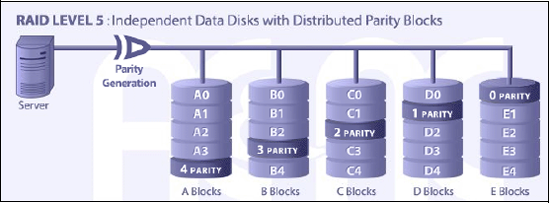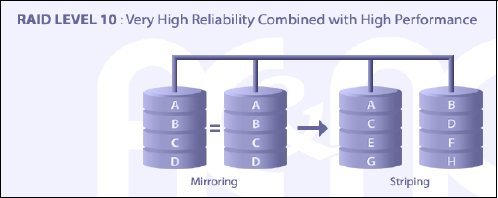2.3. Selecting the appropriate RAID level
In the previous section, we looked at a method for determining the number of disks we need in order to deliver the required I/O performance. This process included adjustments to take into account redundant disks used to provide protection against disk failure. Designing disk redundancy with RAID is the focus of this section.
A good server design is one that has no, or very few, single points of failure. Among the most common server components that fail are disks. Contributing factors include heat and vibration. A good data center design recognizes this and takes measures to reduce failure rates, such as locating servers in temperature-controlled positions with low vibration levels.
Despite environmental precautions, disks still fail, and the server design needs to take this fact into consideration. The commonly used method for providing protection against disk failure is Redundant Array of Independent/Inexpensive Disks, or RAID.
In addition to providing tolerance against disk failure, certain RAID levels increase performance by striping data across multiple disks and therefore distributing I/O load among the disks in the RAID volume. The stripe size, specified when building the RAID volume, can make a significant difference in I/O performance; you'll learn more about this in chapter 3.
This section will look at four RAID levels and their advantages and disadvantages from a cost, fault protection, and performance perspective. Note that there are more RAID levels than discussed here, but these are the common ones used for SQL Server implementations. As with the previous section, this section is geared toward RAID in DAS solutions. SAN-based V-RAID is quite different, although there's usually some correlation between V-RAID and traditional RAID, so the principles are still important.
2.3.1. RAID 0
Despite the name, RAID 0, as shown in figure 2.2, actually provides no redundancy at all. It involves striping data across all the disks in the RAID array, which improves performance, but if any of the disks in the array fail, then the whole array fails. In that sense, RAID 0 actually increases the chance of failure. Consider RAID 0 as the zero redundancy RAID.
Some have suggested that RAID 0 may be acceptable for the tempdb database, given that tempdb starts out empty every time SQL Server is restarted and therefore redundancy of tempdb isn't really important. Although this is true, it's also true that a failure in any of the tempdb disks will cause SQL Server to fail, and you're then faced with rebuilding the disks before SQL Server can be restarted. For most sites, this would lead to an unacceptable outage.
Figure 2.2. Providing zero disk failure tolerance, a RAID 0 partition is optimized for performance only, and is therefore not suitable for use with SQL Server. (Image provided courtesy of Advanced Computer and Network Corp., http://www.raid.com.)

While RAID 0 increases I/O performance through striping, due to the lack of redundancy it provides, I don't recommend you use it for any serious SQL Server implementation.
2.3.2. RAID 1
RAID 1, as shown in figure 2.3, is essentially disk mirroring. Each disk in a RAID 1 array has a mirror partner, and if one of the disks in a mirrored pair fails, then the other disk is still available and operations continue without any data loss.
Useful for a variety of SQL Server components, including backups and transaction logs, RAID 1 arrays provide good read performance, and write performance suffers little or no overhead.
Figure 2.3. A RAID 1 partition mirrors each disk to a mirror pair, therefore allowing continued operation in the event of a disk failure. (Image provided courtesy of Advanced Computer and Network Corp.)

The downside to RAID 1 is the lower disk utilization. For every usable disk, two disks are required, resulting in a 50 percent utilization level.
2.3.3. RAID 5
RAID 5, as shown in figure 2.4, requires at least three disks. It addresses the low disk utilization inherent with RAID 1 by using parity to provide redundancy rather than storing a duplicate copy of the data on another disk. When a disk failure occurs in a RAID 5 array, the data stored on that disk is dynamically recovered using the parity information on the remaining disks.
Figure 2.4. Each write to a RAID 5 partition involves multiple reads to calculate and store parity information. For SQL Server systems with substantial write activity, RAID 5 is often a poor choice. (Image provided courtesy of Advanced Computer and Network Corp.)

Disk utilization in RAID 5 is calculated as # of drives-1/# of drives. For three disk volumes, the utilization is 66 percent, for five disk volumes, 80 percent, and so forth. RAID 5's main advantage is higher disk utilization than RAID 1, and therefore a lower overall storage cost; however, the downsides are significant. Each write to a RAID 5 array involves multiple disk operations for parity calculation and storage; therefore, the write performance is much lower than other RAID solutions. Further, in the event of a disk failure, read performance is also degraded significantly.
Such overhead makes RAID 5 unsuitable for a lot of SQL Server implementations. Exceptions include installations with either predominantly read-only profiles or those with disk capacity or budgetary constraints that can handle the write overhead.
2.3.4. RAID 10
RAID 10 combines the best features of RAID 1 and 0, without any of the downsides of RAID 5. Also known as RAID 1+0, RAID 10 is the highest performance RAID option. As shown in figure 2.5, RAID 10 offers the high-performance striping of RAID 0 with the fault tolerance of RAID 1's disk mirroring without any of the write overhead of RAID 5.
Figure 2.5. RAID 10 combines the benefits of mirroring and striping while avoiding the parity overhead of RAID 5. As such, a RAID 10 partition provides excellent performance and redundancy at the expense of higher cost. (Image provided courtesy of Advanced Computerand Network Corp.)

The downside of RAID 10 is the cost. Requiring at least four disks, RAID 10 arrays benefit from lots of disks to stripe across, each of which requires a mirror partner. In large deployments, the cost of RAID 10 may be prohibitive for some organizations, with the money perhaps better spent on other infrastructure components.
RAID 10 offers the most advantages to SQL Server and, despite the cost, should be seriously considered for environments requiring both high performance and fault tolerance. Table 2.1 compares RAID 10 with RAID 0, 1, and 5.
| Attribute | RAID 0 | RAID 1 | RAID 5 | RAID 10 |
|---|---|---|---|---|
| Disk failure tolerance | 0 | >=1 | 1 | >=1 |
| Disk utilization % | 100% | 50% | 66%+ | 50% |
| Read performance | High | High | High | High |
| Write performance | High | Medium | Low | Medium |
| SQL Server suitability | Bad | Good | Limited | Good |
Finally, it's worth mentioning that RAID can be implemented at either the software level, via the Windows operating system, or the hardware level, using dedicated RAID controller cards. Software RAID shouldn't be used in server class implementations as doing so consumes operating system resources and doesn't offer the same feature set as hardware implementations. Hardware RAID requires no operating system resources and provides additional benefits, such as more RAID-level options, battery- backed disk cache (covered in chapter 3), and support for swapping out failed disks without bringing down the system.
Let's move on now and cover the different types of storage systems available today.
